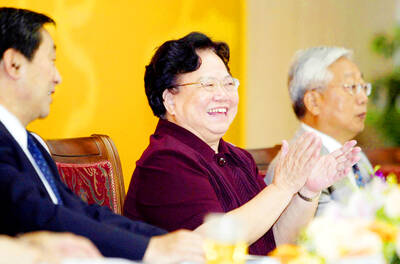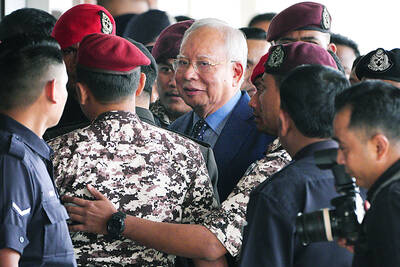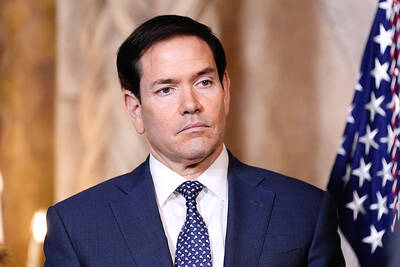An Australian university student who has never visited China and has only a modest social media following would seem an unlikely target for the Chinese government.
However, when a Chinese Ministry of Foreign Affairs spokesman personally denounced Drew Pavlou at a news conference, it was just the next phase in an extraordinary campaign against the 21-year-old that has fueled concerns over China’s targeting of critics overseas.
Pavlou first placed himself in the superpower’s sights when in July last year he organized a small sit-in at the University of Queensland, where he studies, to protest against various Chinese government policies.

Photo: AFP
Since then, the Global Times — a nationalist state-run tabloid — has published a series of articles branding him an “anti-China rioter” and portraying him as the face of alleged anti-Chinese racism in Australia.
Pavlou, a philosophy student, said he had also received death threats after one of China’s envoys in Australia labeled him a “separatist.”
The ministry’s targeting of Pavlou occurred last month when the spokesman was asked about a photograph showing a Chinese diplomat walking across people’s backs in the Pacific island nation of Kiribati.
“There was a person named Drew Pavlou who revealed this photo. This person has always been anti-China out of political motives,” the spokesman said, even though Pavlou neither took the photo nor was the first to share it.
Pavlou said he was playing Grand Theft Auto on his Xbox at the time and that he “was just absolutely shocked.”
“It’s very weird for a superpower to be focusing on one 21-year-old Aussie student, one Aussie bloke who fundamentally is pretty stupid and does a lot of dumb things,” Pavlou told reporters.
At times, Pavlou’s confrontational brand of advocacy has invited criticism, and made him a useful foil for Beijing.
He was accused of racism after posing outside his university’s Chinese-funded Confucius Institute with a sign declaring it a “COVID-19 biohazard” early in the pandemic.
He now regrets the stunt, but still does not understand why Beijing has kept him in its sights.
One explanation is that his advocacy has touched a nerve.
As well as criticizing China’s violent crackdowns in Hong Kong, Xinjiang and Tibet, Pavlou has drawn attention to the cozy relationship between Australian universities and the Chinese state.
Those ties are now being investigated by several Australian authorities for fear the influx of Chinese cash might have jeopardized the national interest.
Elaine Pearson, Australia director for Human Rights Watch, said a “thin-skinned” Beijing had only drawn greater attention to Pavlou and his advocacy.
“It’s pretty obvious from China’s actions more broadly that it really has no tolerance for dissent or opposing views these days,” she said.
Pavlou’s antics also led the University of Queensland (UQ) to amass a 186-page dossier of alleged disciplinary breaches against him, from incendiary social media posts to using a pen in a campus shop without paying for it.
Pavlou was suspended for two years, later reduced to the rest of this year on appeal.
He is suing the university, for A$3.5 million (US$2.56 million) for alleged breach of contract and defamation.
The university has faced high-profile criticism over its handling of Pavlou’s case, including from former Australian prime minister Kevin Rudd, who told local media the institution risked being seen as “bending the knee to Beijing.”
Like many Australian colleges, the university became highly dependent on tuition fees from international students.
A university spokeswoman denied any “political motivations” in pursuing disciplinary action against Pavlou.
“Neither of the findings of serious misconduct concerned Mr Pavlou’s personal or political views,” she said, adding freedom of speech was “of utmost importance to UQ.”

The death of a former head of China’s one-child policy has been met not by tributes, but by castigation of the abandoned policy on social media this week. State media praised Peng Peiyun (彭珮雲), former head of China’s National Family Planning Commission from 1988 to 1998, as “an outstanding leader” in her work related to women and children. The reaction on Chinese social media to Peng’s death in Beijing on Sunday, just shy of her 96th birthday, was less positive. “Those children who were lost, naked, are waiting for you over there” in the afterlife, one person posted on China’s Sina Weibo platform. China’s

‘NO COUNTRY BUMPKIN’: The judge rejected arguments that former prime minister Najib Razak was an unwitting victim, saying Najib took steps to protect his position Imprisoned former Malaysian prime minister Najib Razak was yesterday convicted, following a corruption trial tied to multibillion-dollar looting of the 1Malaysia Development Berhad (1MDB) state investment fund. The nation’s high court found Najib, 72, guilty on four counts of abuse of power and 21 charges of money laundering related to more than US$700 million channeled into his personal bank accounts from the 1MDB fund. Najib denied any wrongdoing, and maintained the funds were a political donation from Saudi Arabia and that he had been misled by rogue financiers led by businessman Low Taek Jho. Low, thought to be the scandal’s mastermind, remains

‘POLITICAL LOYALTY’: The move breaks with decades of precedent among US administrations, which have tended to leave career ambassadors in their posts US President Donald Trump’s administration has ordered dozens of US ambassadors to step down, people familiar with the matter said, a precedent-breaking recall that would leave embassies abroad without US Senate-confirmed leadership. The envoys, career diplomats who were almost all named to their jobs under former US president Joe Biden, were told over the phone in the past few days they needed to depart in the next few weeks, the people said. They would not be fired, but finding new roles would be a challenge given that many are far along in their careers and opportunities for senior diplomats can

Australian Prime Minister Anthony Albanese yesterday announced plans for a national bravery award to recognize civilians and first responders who confronted “the worst of evil” during an anti-Semitic terror attack that left 15 dead and has cast a heavy shadow over the nation’s holiday season. Albanese said he plans to establish a special honors system for those who placed themselves in harm’s way to help during the attack on a beachside Hanukkah celebration, like Ahmed al-Ahmed, a Syrian-Australian Muslim who disarmed one of the assailants before being wounded himself. Sajid Akram, who was killed by police during the Dec. 14 attack, and